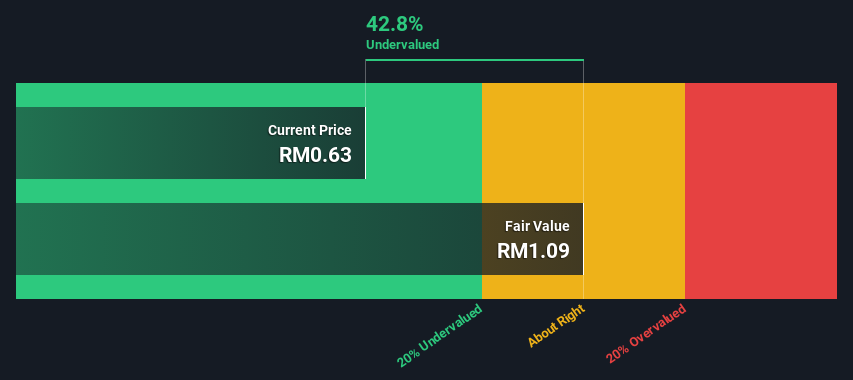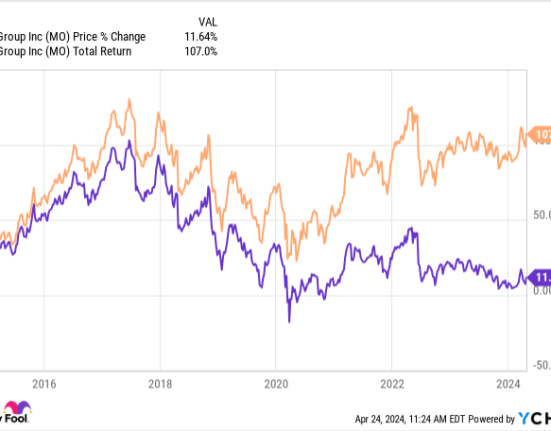Key Insights
-
Using the 2 Stage Free Cash Flow to Equity, DXN Holdings Bhd fair value estimate is RM1.09
-
Current share price of RM0.63 suggests DXN Holdings Bhd is potentially 43% undervalued
-
Our fair value estimate is 23% higher than DXN Holdings Bhd’s analyst price target of RM0.89
Today we will run through one way of estimating the intrinsic value of DXN Holdings Bhd. (KLSE:DXN) by taking the forecast future cash flows of the company and discounting them back to today’s value. This will be done using the Discounted Cash Flow (DCF) model. There’s really not all that much to it, even though it might appear quite complex.
We generally believe that a company’s value is the present value of all of the cash it will generate in the future. However, a DCF is just one valuation metric among many, and it is not without flaws. For those who are keen learners of equity analysis, the Simply Wall St analysis model here may be something of interest to you.
Check out our latest analysis for DXN Holdings Bhd
Is DXN Holdings Bhd Fairly Valued?
We’re using the 2-stage growth model, which simply means we take in account two stages of company’s growth. In the initial period the company may have a higher growth rate and the second stage is usually assumed to have a stable growth rate. To start off with, we need to estimate the next ten years of cash flows. Where possible we use analyst estimates, but when these aren’t available we extrapolate the previous free cash flow (FCF) from the last estimate or reported value. We assume companies with shrinking free cash flow will slow their rate of shrinkage, and that companies with growing free cash flow will see their growth rate slow, over this period. We do this to reflect that growth tends to slow more in the early years than it does in later years.
A DCF is all about the idea that a dollar in the future is less valuable than a dollar today, so we discount the value of these future cash flows to their estimated value in today’s dollars:
10-year free cash flow (FCF) estimate
|
2024 |
2025 |
2026 |
2027 |
2028 |
2029 |
2030 |
2031 |
2032 |
2033 |
|
|
Levered FCF (MYR, Millions) |
RM335.3m |
RM343.4m |
RM391.9m |
RM271.0m |
RM260.0m |
RM454.0m |
RM475.0m |
RM495.4m |
RM515.6m |
RM535.8m |
|
Growth Rate Estimate Source |
Analyst x3 |
Analyst x3 |
Analyst x3 |
Analyst x1 |
Analyst x1 |
Analyst x1 |
Est @ 4.63% |
Est @ 4.30% |
Est @ 4.07% |
Est @ 3.91% |
|
Present Value (MYR, Millions) Discounted @ 10% |
RM304 |
RM282 |
RM292 |
RM183 |
RM159 |
RM252 |
RM239 |
RM226 |
RM213 |
RM201 |
(“Est” = FCF growth rate estimated by Simply Wall St)
Present Value of 10-year Cash Flow (PVCF) = RM2.4b
We now need to calculate the Terminal Value, which accounts for all the future cash flows after this ten year period. For a number of reasons a very conservative growth rate is used that cannot exceed that of a country’s GDP growth. In this case we have used the 5-year average of the 10-year government bond yield (3.5%) to estimate future growth. In the same way as with the 10-year ‘growth’ period, we discount future cash flows to today’s value, using a cost of equity of 10%.
Terminal Value (TV)= FCF2033 × (1 + g) ÷ (r – g) = RM536m× (1 + 3.5%) ÷ (10%– 3.5%) = RM8.2b
Present Value of Terminal Value (PVTV)= TV / (1 + r)10= RM8.2b÷ ( 1 + 10%)10= RM3.1b
The total value is the sum of cash flows for the next ten years plus the discounted terminal value, which results in the Total Equity Value, which in this case is RM5.4b. The last step is to then divide the equity value by the number of shares outstanding. Relative to the current share price of RM0.6, the company appears quite undervalued at a 43% discount to where the stock price trades currently. Valuations are imprecise instruments though, rather like a telescope – move a few degrees and end up in a different galaxy. Do keep this in mind.
The Assumptions
The calculation above is very dependent on two assumptions. The first is the discount rate and the other is the cash flows. You don’t have to agree with these inputs, I recommend redoing the calculations yourself and playing with them. The DCF also does not consider the possible cyclicality of an industry, or a company’s future capital requirements, so it does not give a full picture of a company’s potential performance. Given that we are looking at DXN Holdings Bhd as potential shareholders, the cost of equity is used as the discount rate, rather than the cost of capital (or weighted average cost of capital, WACC) which accounts for debt. In this calculation we’ve used 10%, which is based on a levered beta of 1.065. Beta is a measure of a stock’s volatility, compared to the market as a whole. We get our beta from the industry average beta of globally comparable companies, with an imposed limit between 0.8 and 2.0, which is a reasonable range for a stable business.
SWOT Analysis for DXN Holdings Bhd
Strength
Weakness
Opportunity
Threat
Next Steps:
Although the valuation of a company is important, it ideally won’t be the sole piece of analysis you scrutinize for a company. The DCF model is not a perfect stock valuation tool. Instead the best use for a DCF model is to test certain assumptions and theories to see if they would lead to the company being undervalued or overvalued. If a company grows at a different rate, or if its cost of equity or risk free rate changes sharply, the output can look very different. Can we work out why the company is trading at a discount to intrinsic value? For DXN Holdings Bhd, we’ve put together three further elements you should look at:
-
Risks: Case in point, we’ve spotted 1 warning sign for DXN Holdings Bhd you should be aware of.
-
Future Earnings: How does DXN’s growth rate compare to its peers and the wider market? Dig deeper into the analyst consensus number for the upcoming years by interacting with our free analyst growth expectation chart.
-
Other High Quality Alternatives: Do you like a good all-rounder? Explore our interactive list of high quality stocks to get an idea of what else is out there you may be missing!
PS. Simply Wall St updates its DCF calculation for every Malaysian stock every day, so if you want to find the intrinsic value of any other stock just search here.
Have feedback on this article? Concerned about the content? Get in touch with us directly. Alternatively, email editorial-team (at) simplywallst.com.
This article by Simply Wall St is general in nature. We provide commentary based on historical data and analyst forecasts only using an unbiased methodology and our articles are not intended to be financial advice. It does not constitute a recommendation to buy or sell any stock, and does not take account of your objectives, or your financial situation. We aim to bring you long-term focused analysis driven by fundamental data. Note that our analysis may not factor in the latest price-sensitive company announcements or qualitative material. Simply Wall St has no position in any stocks mentioned.








